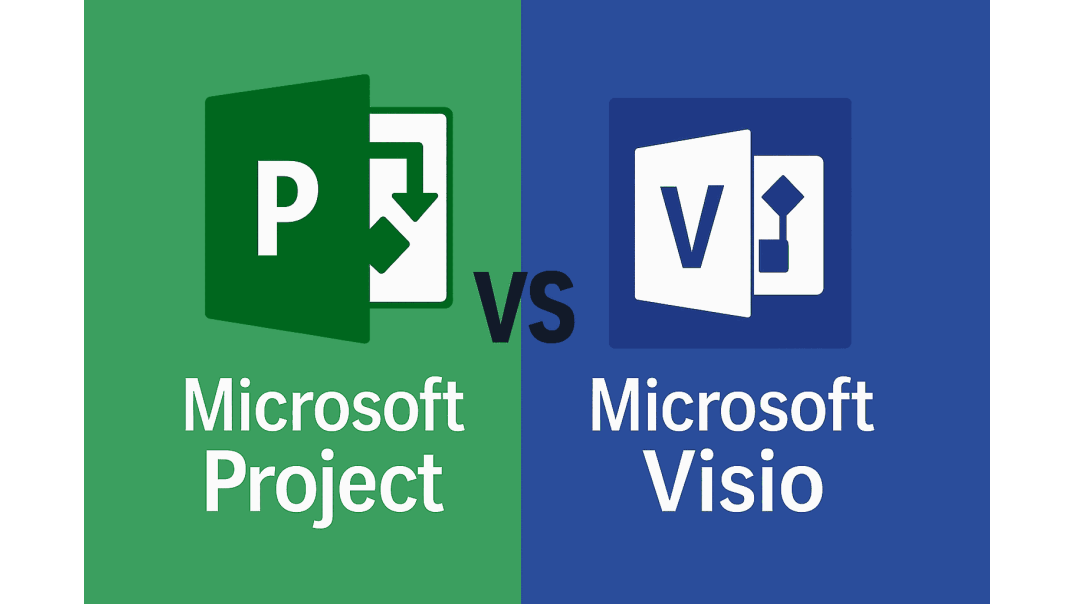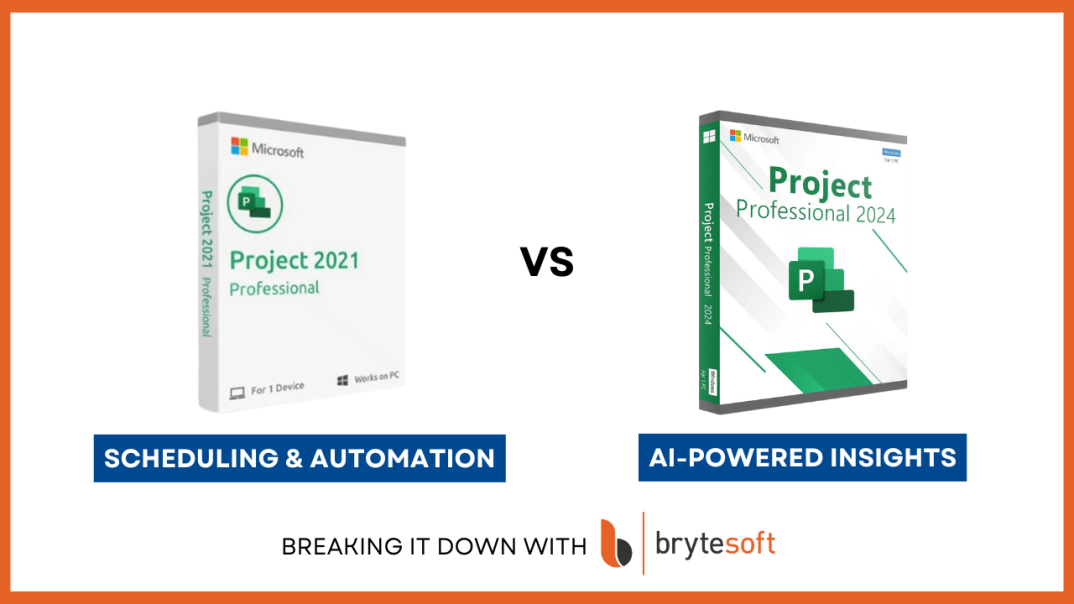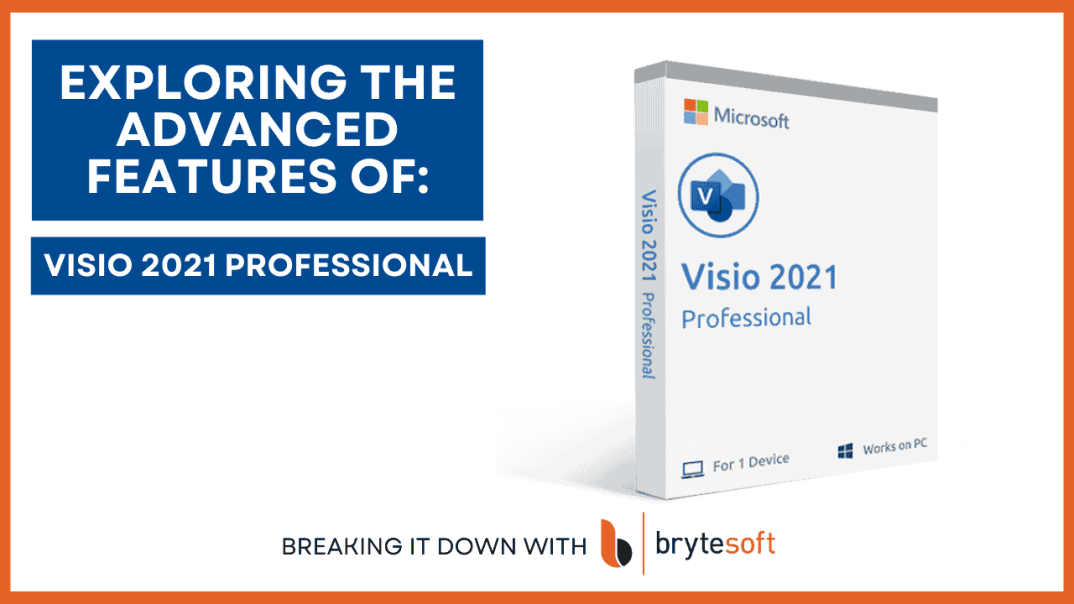Microsoft Project vs. Visio
Microsoft Project and Visio are powerful tools often used to manage projects and visualize complex data. But are they the right fit for small teams and freelancers? In this article, we'll explore the features of Microsoft Project and Visio and help you decide if they're worth the investment for your specific needs.
Understanding Microsoft Project and Visio
Before diving into the details, it's essential to understand what these tools are designed to do. Each tool serves a distinct purpose and offers unique functionalities tailored to different types of work.
What is Microsoft Project?
Microsoft Project is a project management software that helps teams plan, execute, and monitor projects. It offers a range of features such as task management, resource allocation, and timeline creation. It's particularly popular among larger organizations with complex project needs, but it can also be helpful for small teams and freelancers who require detailed project oversight.
Key Components
At its core, Microsoft Project is built around key components that facilitate project management. These include project scheduling, resource management, and task dependencies. Understanding these components is crucial for leveraging the software's full potential.
Benefits for Various Teams
While Microsoft Project is often associated with large corporations, small teams can also benefit significantly. The software's ability to streamline project workflows, allocate resources efficiently, and predict project timelines can be invaluable, even for smaller operations.
Learning and Adoption
Despite its advantages, Microsoft Project does have a learning curve. Small teams and freelancers might find it initially challenging to navigate the software. However, with time and practice, users can harness its capabilities to enhance productivity and project accuracy.
What is Microsoft Visio?
Conversely, Visio is a diagramming tool that creates flowcharts, organizational charts, network diagrams, and more. It's designed to help users visualize data and processes, making understanding and communicating complex information easier. Visio can be a valuable tool for anyone who needs to present data in a clear and organized manner.
Types of Diagrams You Can Create with Visio
Visio is versatile, allowing users to create various diagrams. Whether you're mapping out a business process, designing a network architecture, or developing a floor plan, Visio provides the templates and tools needed to get started effectively.
Ease of Use
One of Visio's standout features is its user-friendly interface. Even users without extensive design experience can quickly create professional-looking diagrams. This ease of use makes it accessible to freelancers and small teams without dedicated design personnel.
Applications Across Industries
Visio's functionality extends across various industries. From IT departments visualizing network setups to HR teams organizing company structures, Visio caters to a broad spectrum of professional needs, making it a versatile tool in any business toolkit.
Key Features of Microsoft Project
Microsoft Project offers a variety of features that can be beneficial for project management. Here are some of the most notable ones:
Task Management
One of Microsoft Project's core features is task management. Users can create tasks, assign them to team members, set deadlines, and track progress. This feature is crucial for keeping projects on schedule and ensuring everyone knows their responsibilities.
Assigning Tasks and Responsibilities
Assigning tasks is more than just delegating work; it's about aligning team members' strengths with project needs. Microsoft Project facilitates this by allowing managers to match tasks with the best-suited team members, enhancing efficiency and accountability.
Monitoring Task Progress
Tracking progress is essential for project success. Microsoft Project provides real-time updates and progress tracking, ensuring that team members and stakeholders know the current status and potential roadblocks.
Adjusting Tasks and Deadlines
Projects often encounter unforeseen challenges. Microsoft Project allows managers to adjust tasks and deadlines dynamically, helping teams remain agile and responsive to changes without losing sight of overall goals.
Resource Management
Managing resources effectively is vital for any project. Microsoft Project allows users to allocate resources, track usage, and manage costs. This can help small teams and freelancers optimize their resources and prevent over-allocation.
Understanding Resource Allocation
Resource allocation is a critical component of project management. Microsoft Project enables managers to allocate human, financial, and material resources efficiently, ensuring optimal utilization and avoiding bottlenecks.
Cost Management and Forecasting
Cost management is integral to project success. Microsoft Project provides tools for tracking expenses and forecasting future costs, helping teams manage budgets and make informed financial decisions.
Resource Conflict Resolution
Resource conflicts can derail projects. Microsoft Project identifies potential conflicts and provides solutions for resolving them, ensuring that resources are used effectively and without overlap.
Timeline and Gantt Charts
Visualizing a project's timeline is essential for understanding its progress. Microsoft Project offers Gantt charts, which visually represent a project's schedule. This feature helps teams see the start and end dates of tasks, dependencies, and milestones.
Creating Effective Gantt Charts
Gantt charts are more than just visual tools; they are strategic instruments for planning. Microsoft Project's Gantt chart feature enables users to create detailed timelines that highlight task sequences, dependencies, and critical paths.
Analyzing Project Dependencies
Dependencies can complicate project timelines. Microsoft Project helps teams identify and manage these dependencies, ensuring that delays in one area do not cascade through the entire project.
Tracking Milestones
Milestones are key to measuring progress. Microsoft Project enables teams to set and track milestones, providing clear indicators of project progress and helping maintain momentum toward completion.
Reporting
Microsoft Project includes reporting tools that allow users to generate reports on project status, resource usage, and more. These reports can be customized and shared with stakeholders, providing valuable insights into the project's progress.
Customizing Reports
Customization is crucial for effective reporting. Microsoft Project provides a range of customizable report templates, enabling teams to tailor reports to specific audiences and project requirements.
Sharing Insights with Stakeholders
Communication with stakeholders is vital for project success. Microsoft Project's reporting tools facilitate transparent communication, ensuring stakeholders are informed and engaged throughout the project lifecycle.
Utilizing Data for Future Projects
Reports are not just about current projects; they are valuable for future planning. Microsoft Project helps teams analyze past performance, learn from successes and mistakes, and apply insights to future projects.
Key Features of Microsoft Visio
Visio is a versatile tool that offers various features for creating professional diagrams. Here are some of the key features:
Diagram Creation
Visio provides an extensive library of templates and shapes for creating diagrams. Whether you need to create a flowchart, network diagram, or floor plan, Visio has the tools to help you get started.
Exploring Template Libraries
Templates are vital for efficient diagramming. Visio's extensive library offers templates for various diagram types, allowing users to jumpstart their projects without starting from scratch.
Crafting Custom Diagrams
While templates are helpful, customization is often necessary. Visio enables users to create and modify unique diagrams tailored to specific needs, offering flexibility and creativity.
Enhancing Diagram Clarity
Clarity is essential in diagramming. Visio's tools help users create diagrams that are not only visually appealing but also easy to understand, ensuring that complex information is communicated effectively and clearly.
Data Linking
One of Visio's standout features is its ability to link diagrams to data sources. This means you can create dynamic diagrams that update automatically when the underlying data changes. This feature is handy for creating dashboards and visual reports.
Integrating Data with Diagrams
Data integration enhances diagram functionality. Visio enables users to link diagrams with real-time data, creating dynamic visuals that reflect the most up-to-date information.
Automating Diagram Updates
Manual updates can be time-consuming. Visio's data linking feature automates updates, ensuring that diagrams remain accurate and up-to-date without additional effort.
Creating Interactive Dashboards
Dashboards are powerful tools for data visualization. Visio enables users to create interactive dashboards that provide comprehensive insights, helping teams make informed decisions.
Collaboration
Collaboration is crucial for any team, and Visio makes it easy to collaborate on diagrams. Users can share diagrams with others, leave comments, and collaborate in real time. This feature helps ensure everyone is on the same page and can contribute to the project.
Real-Time Collaboration
Real-time collaboration facilitates teamwork. Visio's collaborative tools allow multiple users to work on diagrams simultaneously, fostering a seamless team environment.
Sharing and Commenting
Feedback is essential for improvement. Visio allows users to share diagrams and receive comments, ensuring all team members can contribute their insights and suggestions.
Ensuring Version Control
Version control is vital for maintaining accuracy. Visio's collaboration features ensure that all team members are working on the latest version of a diagram, preventing confusion and discrepancies.
Integration with Other Microsoft Tools
Visio integrates seamlessly with other Microsoft tools like Excel and SharePoint. This integration enables users to import data from Excel into Visio diagrams and share them via SharePoint, facilitating easier collaboration and information sharing.
Importing Data from Excel
Excel is a common data source. Visio's integration with Excel allows users to import and visualize data effortlessly, creating cohesive and informative diagrams.
Sharing via SharePoint
SharePoint is a powerful collaboration platform. Visio's integration with SharePoint ensures that diagrams can be easily accessed, enhancing team collaboration and information dissemination.
Enhancing Workflow Efficiency
Integration enhances workflow efficiency. By connecting Visio with other Microsoft tools, teams can streamline processes and enhance productivity, ensuring all tools work in harmony.
Microsoft Project vs. Visio: What's the Difference?
Microsoft Project and Visio are powerful tools, but serve different purposes. Microsoft Project focuses on project management, while Visio is designed for creating diagrams and visualizing data. Here's a quick comparison of their key features:
Purpose and Functionality
Each tool has distinct purposes. Microsoft Project is tailored for planning and managing projects, offering features that cater to task management, resource allocation, and timeline visualization. Visio, however, focuses on diagramming and visual communication, providing tools for creating detailed diagrams and data visualizations.
Core Features and Capabilities
The core features of each tool reflect their intended use. Microsoft Project emphasizes task management, Gantt charts, and resource tracking, all of which are essential for comprehensive project oversight. Conversely, Visio excels in diagram creation, data linking, and collaboration, enabling users to visualize complex information effectively.
Ideal Use Cases
Understanding the ideal use cases for each tool is crucial for making an informed decision. Microsoft Project suits teams requiring detailed project oversight and resource management. In contrast, Visio is better for those who need to visualize processes, organize information, and communicate data effectively.
Are They Worth It for Small Teams and Freelancers?
Whether Microsoft Project and Visio are worth the investment depends on your needs. Both tools offer significant advantages, but their value varies based on the nature of your work and your team's requirements.
Considerations for Microsoft Project
Microsoft Project could benefit if you're a small team or freelancer working on complex projects requiring detailed planning and resource management. It provides the tools to keep projects on track, manage resources, and report progress. However, it comes with a learning curve and may be more robust than necessary for simpler projects.
Evaluating Project Complexity
Assessing the complexity of your projects is essential. Microsoft Project's comprehensive features can provide the structure and control you need if your projects involve multiple tasks and resource dependencies and require detailed oversight.
Budget and Investment Considerations
Cost is a significant factor for small teams. While Microsoft Project offers robust features, it requires an investment that may not be justified for straightforward projects. Evaluating your budget and project needs is crucial before committing.
Training and Support Needs
Training is necessary for maximizing Microsoft Project's potential. Consider the resources required for learning and ongoing support to ensure your team can effectively utilize the software's capabilities without excessive strain.
Considerations for Visio
Visio is an excellent option for creating professional diagrams and visualizing data. It's user-friendly and offers numerous templates and shapes to help you get started. Visio is worth considering if your work involves presenting complex information clearly and in an organized manner. However, there may be more cost-effective alternatives if you only need basic diagramming capabilities.
Assessing Diagramming Needs
Understanding your diagramming needs is crucial. Visio's advanced features can significantly enhance your work if your projects involve complex data visualization and process mapping or require clear information communication.
Balancing Cost and Functionality
Cost-effectiveness is essential for freelancers and small teams. While Visio offers extensive capabilities, consider whether simpler, less expensive tools meet your needs without compromising quality.
Exploring Alternative Tools
Alternatives to Visio exist, especially for basic diagramming needs. Exploring these options can help determine whether Visio's specific features are necessary or if a more straightforward tool suffices for your projects.
Final Thoughts
Ultimately, the decision to invest in Microsoft Project and Visio depends on your specific needs and budget. Both tools offer robust features that can enhance productivity and communication, but they may not be necessary for every small team or freelancer. Consider your project management and diagramming needs carefully, and explore free trials or alternatives to determine the best fit for your workflow.
By understanding each tool's strengths and how they align with your work, you can make an informed decision that supports your project goals and enhances your team's efficiency. Whether managing complex projects or visualizing detailed diagrams, selecting the right tools can significantly impact your productivity and success.
FAQ About Microsoft Project vs Visio: Which Is Best for Teams & Freelancers?
What is the main difference between Microsoft Project and Visio?
Microsoft Project is primarily a project management tool focusing on task management, resource allocation, and timeline visualization. In contrast, Visio is designed to create diagrams and visual representations, making it ideal for visualizing complex information and processes.
Is Microsoft Project suitable for small teams and freelancers?
Microsoft Project can benefit small teams and freelancers working on complex projects requiring detailed planning and oversight. However, the software has a learning curve, so teams should assess their project management needs before investing.
Can Visio be used for basic diagramming tasks?
Absolutely! Visio is user-friendly and offers a variety of templates and shapes that make it easy to create simple and complex diagrams. It's an excellent tool for anyone looking to visualize data clearly and effectively.







